Here is a confirmed bug report with Oracle: http://bugs.mysql.com/bug.php?id=67183
Situation
When using an .Include chain inside of my repository, I noticed that I was getting strange results - mostly that the values queried that were being returned were from the wrong fields (name would end up in description for example - but in the database all the values are correct, they only show up wrong after the query). I changed the names so the relationships are more obvious, but the structure is the same. I keep getting the wrong values for the associated CrewMember and their relative Rank and Clearance. It seems if there is a field name which is the same in CrewMember as Rank, then the value of that field in Rank becomes what the value was in CrewMember. For example, if Rank had a description, and so did CrewMember, then the description of Rank for the CrewMember would be the CrewMember's description.
Entity Framework fails to make well formed queries past a depth of 2 when there are similar fields defined as a result of the MySQL Connector/NET sql provider failing to properly form join statements.
Definitions
This is a class definition which models a database table. I am using C# ASP.NET MVC 3 with the Entity Framework 4.1 and the MySQL Connector/NET version 6.5
public class Harbor
{
public int HarborId { get; set; }
public virtual ICollection<Ship> Ships { get; set; }
public string Description { get; set; }
}
public class Ship
{
public int ShipId { get; set; }
public int HarborId { get; set; }
public virtual Harbor Harbor { get; set; }
public virtual ICollection<CrewMember> CrewMembers { get; set; }
public string Description { get; set; }
}
public class CrewMember
{
public int CrewMemberId { get; set; }
public int ShipId { get; set; }
public virtual Ship Ship { get; set; }
public int RankId { get; set; }
public virtual Rank Rank { get; set; }
public int ClearanceId { get; set; }
public virtual Clearance Clearance { get; set; }
public string Description { get; set; }
}
public class Rank
{
public int RankId { get; set; }
public virtual ICollection<CrewMember> CrewMembers { get; set; }
public string Description { get; set; }
}
public class Clearance
{
public int ClearanceId { get; set; }
public virtual ICollection<CrewMember> CrewMembers { get; set; }
public string Description { get; set; }
}
Query
This is the code which queries the database and has the query and .Include calls.
DbSet<Harbor> dbSet = context.Set<Harbor>();
IQueryable<Harbor> query = dbSet;
query = query.Include(entity => entity.Ships);
query = query.Include(entity => entity.Ships.Select(s => s.CrewMembers));
query = query.Include(entity => entity.Ships.Select(s => s.CrewMembers.Select(cm => cm.Rank)));
query = query.Include(entity => entity.Ships.Select(s => s.CrewMembers.Select(cm => cm.Clearance)));
Are these .Include calls well formed? Did I miss something?
This is rather complex, so if you have any questions please let me know in comments and I will try to clarify anything I may have left out.
How can I use Entity Framework to get a well formed query on an object graph past a depth of 2 when using MySQL Connector / NET?
Edits
Here is the generated query:
{SELECT
[Project1].[HarborId],
[Project1].[Description],
[Project1].[C2] AS [C1],
[Project1].[ShipId],
[Project1].[HarborId1],
[Project1].[Description1],
[Project1].[C1] AS [C2],
[Project1].[CrewMemberId],
[Project1].[ShipId1],
[Project1].[ClearanceId],
[Project1].[RankId],
[Project1].[Description2],
[Project1].[RankId1],
[Project1].[Description3],
[Project1].[ClearanceId1],
[Project1].[Description4],
FROM (SELECT
[Extent1].[HarborId],
[Extent1].[Description],
[Join3].[ShipId],
[Join3].[HarborId] AS [HarborId1],
[Join3].[Description]AS [Description1],
[Join3].[CrewMemberId],
[Join3].[ShipId]AS [ShipId1],
[Join3].[ClearanceId],
[Join3].[RankId],
[Join3].[Description] AS [Description2],
[Join3].[RankId] AS [RankId1],
[Join3].[Description] AS [Description3],
[Join3].[ClearanceId] AS [ClearanceId1],
[Join3].[Description] AS [Description4],
CASE WHEN ([Join3].[ShipId] IS NULL) THEN (NULL) WHEN ([Join3].[CrewMemberId] IS NULL) THEN (NULL) ELSE (1) END AS [C1],
CASE WHEN ([Join3].[ShipId] IS NULL) THEN (NULL) ELSE (1) END AS [C2]
FROM [Harbor] AS [Extent1] LEFT OUTER JOIN (SELECT
[Extent2].[ShipId],
[Extent2].[HarborId],
[Extent2].[Description],
[Join2].[CrewMemberId],
[Join2].[ShipId] AS [ShipID1],
[Join2].[ClearanceId],
[Join2].[RankId],
[Join2].[Description] AS [DESCRIPTION1],
[Join2].[RankID1],
[Join2].[DESCRIPTION1] AS [DESCRIPTION11],
[Join2].[ClearanceID1],
[Join2].[DESCRIPTION2],
FROM [Ship] AS [Extent2] LEFT OUTER JOIN (SELECT
[Extent3].[CrewMemberId],
[Extent3].[ShipId],
[Extent3].[ClearanceId],
[Extent3].[RankId],
[Extent3].[Description],
[Extent4].[RankId] AS [RankID1],
[Extent4].[Description] AS [DESCRIPTION1],
[Extent5].[ClearanceId] AS [ClearanceID1],
[Extent5].[Description] AS [DESCRIPTION2],
FROM [CrewMember] AS [Extent3] INNER JOIN [Rank] AS [Extent4] ON [Extent3].[RankId] = [Extent4].[RankId] LEFT OUTER JOIN [Clearance] AS [Extent5] ON [Extent3].[ClearanceId] = [Extent5].[ClearanceId]) AS [Join2] ON [Extent2].[ShipId] = [Join2].[ShipId]) AS [Join3] ON [Extent1].[HarborId] = [Join3].[HarborId]
WHERE [Extent1].[HarborId] = @p__linq__0) AS [Project1]
ORDER BY
[Project1].[HarborId] ASC,
[Project1].[C2] ASC,
[Project1].[ShipId] ASC,
[Project1].[C1] ASC}
Clarification
Using include on 1-1 relationships poses no problem when "drilling down" in this fashion it seems. However, the issue seems to arise when there are 1-many relations as part of the drilling. The drilling is necessary in order to eager load.
The first projection, entity => entity.Ships.Select(s => s.CrewMembers, will return a list of CrewMembers which are related to each ship. This properly returns the graph where a harbor contains a list of ships, each with a list of crew members.
However, the second projection CrewMembers.Select(cm => cm.Rank, does not in fact return the proper piece of the graph. Fields begin to be mixed, and any fields sharing the same name will default for whatever reason to the parent field. This results in inconsistent results and more importantly bad data. The fact that no errors are thrown makes it worse, as this can only be determined through runtime inspection.
If there were a way to somehow get a strongly typed single response (as opposed to a list) from the first projection, perhaps the second would not be necessary. As it is now, I believe that the issue lies in the first projection returning a list. When the second projection attempts to project based on that list instead of from a single object, the logical error is introduced.
If, instead of CrewMembers being an ICollection, it was only one CrewMember, then this nested projection will in fact return the correct data. However, that is a simplified version of this problem and unfortunately it is what almost all testing seems to have been done on from the various blogs, tutorials, posts, articles, and documents which I reviewed trying to solve this issue.
